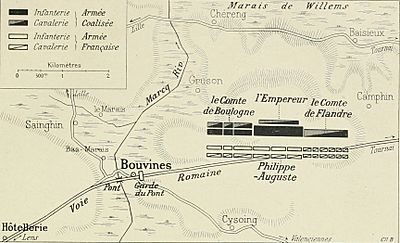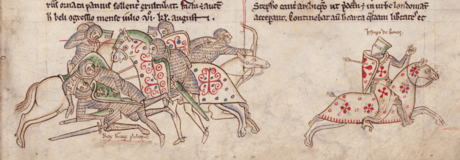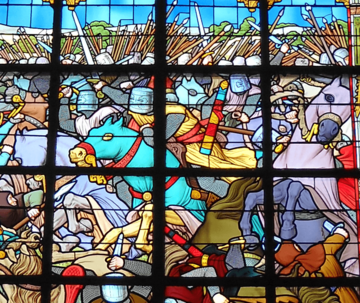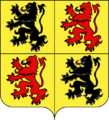Battle of Bouvines facts for kids
Quick facts for kids Battle of Bouvines |
|||||||
|---|---|---|---|---|---|---|---|
| Part of the Anglo-French War of 1213–1214 | |||||||
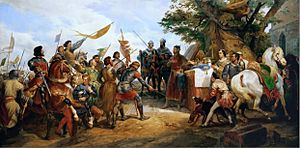 La Bataille de Bouvines, by Horace Vernet in 1827. (Galerie des Batailles, Palace of Versailles). |
|||||||
|
|||||||
| Belligerents | |||||||
|
Kingdom of
France
|
Angevin empire Minor participants
|
||||||
| Commanders and leaders | |||||||
List
centre:
left flank:
right flank:
other command:
|
List
centre:
right flank:
left flank:
|
||||||
| Strength | |||||||
|
6,000–7,000
|
8,800–9,000
|
||||||
| Casualties and losses | |||||||
|
|
||||||
The Battle of Bouvines was a major fight that happened on July 27, 1214. It took place near the town of Bouvines in what is now France. This battle was the final big event of the Anglo-French War of 1213–1214.
In this battle, the French army, led by King Philip Augustus, defeated a larger army. This bigger army was made up of soldiers from different countries, led by Holy Roman Emperor Otto IV. The Battle of Bouvines was one of the most important battles of the medieval period.
Before the battle, several leaders teamed up against King Philip Augustus of France. This group included Emperor Otto IV, King John of England, and leaders from Flanders, Boulogne, Brabant, Holland, Lorraine, and Limburg. Their goal was to win back lands that Philip had taken earlier in his rule.
The battle happened after some careful movements by both armies. The Allied army was slow to get into position, which put them at a disadvantage. The French knights were very well-trained and disciplined. They made strong attacks that broke through the Flemish knights on the Allied left side.
In the middle of the battle, Emperor Otto's soldiers had some success. They pushed back the French foot soldiers and almost captured King Philip. But French knights fought back, defeating Otto's soldiers. Otto himself had to escape the battle. The French knights then captured the Imperial eagle flag. With the middle and left sides of the Allied army defeated, only a few soldiers on the right side kept fighting. They were eventually killed, captured, or forced to leave. The French did not chase them because it was getting dark.
The French victory was a huge blow to England and Flanders. They lost their chance to get back their lands. After the battle, Emperor Otto IV lost his power and was replaced by Frederick II. King John of England had to give up Anjou to Philip. This battle also weakened King John so much that his nobles forced him to sign the Magna Carta in 1215. This document limited the king's power. The leaders of Flanders, Boulogne, and Salisbury were captured and put in prison. The battle changed the balance of power in Europe, making France a much stronger country.
Contents
Why the Battle Happened
In 1214, Ferdinand, the Count of Flanders, wanted to get back the cities of Aire-sur-la-Lys and Saint-Omer. He had lost these cities to King Philip II in an earlier agreement. So, Ferdinand decided to stop supporting King Philip.
He then formed a large alliance against Philip. This group included Emperor Otto IV, King John of England, and other powerful dukes and counts.
King John of England planned the campaign. His idea was to make the French army move south towards his forces. This would keep them busy while the main Allied army, led by Emperor Otto IV, marched on Paris from the north. John's plan started well, but the Allied forces in the north moved very slowly. After two small fights, King John retreated to Aquitaine on July 3.
By July 23, King Philip had gathered his army, which included about 6,000 to 8,000 soldiers. The Emperor finally brought his forces together at Valenciennes, but King John was not with them. Philip then moved his army north and got ready for battle. Philip decided to attack. He found a good spot for his cavalry (soldiers on horseback) and offered battle on July 27. This was on a plain east of Bouvines, near the Marque river.
Otto was surprised by how fast Philip moved. He was caught off guard, as Philip had likely tricked him into a trap. Otto decided to attack what was then the French army's rear (back).
The Allied army lined up facing southwest towards Bouvines. Their heavy cavalry was on the sides, and their foot soldiers were in a large group in the middle. Emperor Otto himself led a group of cavalry in the center. The French army lined up in a similar way, with cavalry on the sides and foot soldiers (including town militias) in the middle. King Philip, with his reserve cavalry and the royal flag (the Oriflamme), stood behind his foot soldiers.
Who Fought: The Armies
The French army had about 1,200 to 1,360 knights. Many of these knights were from the king's own lands. King Philip also asked towns in northern France for help.
- Many towns sent foot soldiers. For example, Arras sent 1,000 soldiers, and Beauvais sent 500.
- In total, the French army had about 6,000 to 7,000 soldiers. The royal flag was carried by Galore of Montigny.
The French army was split into three main groups:
- The right side was led by Eudes, Duke of Burgundy. It included knights from Champagne and Burgundy.
- The middle group was led by King Philip Augustus himself. It had many of his best knights and foot soldiers from towns like Île de France and Normandy.
- The left side was led by Robert of Dreux. It included soldiers from Dreux, Perche, and other areas.
- A small group of 150 soldiers guarded the only bridge across the marshes, which was important for retreat.
Emperor Otto's army had about 1,300 to 1,500 knights and about 7,500 foot soldiers. This made his total force almost 9,000 men. The Imperial army was also in three groups:
- The left side was led by Ferrand of Flanders with his Flemish knights and foot soldiers.
- The middle was led by Emperor Otto himself. It included many German soldiers and knights from Brabant and Lorraine.
- The right side was led by Renaud de Dammartin. It had foot soldiers from Brabant and English knights, led by William Longespée.
- English archers (bowmen) were also on the far right side.
The Battle Begins
Fighting on the Allied Left
The battle started with a small attack by French light cavalry. They tried to confuse the Flemish knights on the Allied left side. The Flemish knights easily pushed them back. Some Flemish knights then chased the French cavalry, but this was a mistake. French knights from Champagne quickly attacked these Flemish knights, capturing or killing them. The Count of Flanders then attacked with all his 600 knights, pushing the French back.
French knights, led by Gaucher de Châtillon, then charged the Flemish. They kept attacking, stopping the Allied advance. Many knights on both sides fell from their horses. The French were more organized than the Flemish, and the Allied lines started to break. French knights even attacked the Flemish from behind. The fighting was very hard, and the Duke of Burgundy's horse was killed, but his knights saved him.
The Flemish knights fought for three hours, even though they were in a bad situation. They fought bravely because of their knightly honor. Finally, the Count of Flanders was captured by two French knights. This made his soldiers lose hope, and their morale collapsed.
The Center of the Battle
In the middle, the French foot soldiers were attacked by Allied knights and foot soldiers led by Emperor Otto. The French soldiers were pushed back. Otto and his knights almost reached the French king, Philip, but French knights stopped them. Allied foot soldiers broke through to King Philip and his few knights, knocking him off his horse with their hooked spears. King Philip's armor saved his life. Another knight quickly gave Philip a new horse.
The Allied foot soldiers used daggers to stab French knights who had fallen off their horses. They aimed for weak spots in their armor. The French lost many soldiers this way. After many French counterattacks and a long fight, the Allies were pushed back.
The battle in the center became a big fight between the two leaders, King Philip and Emperor Otto. A French knight almost captured Otto. Another soldier stabbed Otto's horse in the eye, killing it. Otto was saved by four German lords. As more French knights attacked him, he fled the battlefield. The German knights fought until the end to save their emperor, but they were all killed or captured. The Imperial flag, with its eagle and dragon, was captured by the French. At this point, the Allied resistance in the center stopped.
The Allied Right Side
Meanwhile, on the French left side, soldiers led by Robert de Dreux were fighting against William Longespée's troops. William Longespée was knocked off his horse and captured by the Bishop of Beauvais. The English soldiers then ran away. Mathieu de Montmorency captured twelve enemy flags.
The Last Stand
The battle was already won by the French when their sides started to close in, trapping the Imperial center. The fighting ended with a famous stand by Reginald of Boulogne (Renaud de Dammartin). He was a former supporter of King Philip. Reginald formed a circle of 400 to 700 pikemen (soldiers with long spears). They bravely fought off every attack by the French cavalry. Reginald also made several quick attacks with his small group of knights.
Eventually, long after the main Imperial army had left, the pikemen's circle was broken by a charge of 50 knights and 1,000 to 2,000 foot soldiers. Reginald was captured in the fight. The French did not chase the fleeing soldiers because it was getting dark, and they worried prisoners might escape. French trumpets were used to call their soldiers back.
What Happened After the Battle
The French army had very few losses, with only 2 knights killed. The Allied army, however, lost 169 knights and many foot soldiers. Many important leaders were captured by the French, including Reginald of Boulogne, Ferrand of Hainaut, and William Longespée.
This battle ended the threats from both Emperor Otto and King John. Historians say Bouvines was one of the most important battles in French history.
King Philip returned to Paris in triumph. He marched his captured enemies in a long parade, and his people cheered him. After the battle, Otto went back to his castle and was soon removed from power as Holy Roman Emperor. Frederick II became the new emperor. Count Ferdinand remained in prison, and King John of England had to agree to a five-year truce (a ceasefire) on easy terms.
Philip's big victory was very important for England. The battle ended any hope of bringing back the Angevin Empire. King John was so weakened that his nobles forced him to agree to the Magna Carta in 1215. This document limited the king's power and helped create the basis for common law.
Remembering the Battle
To show thanks for the victory, King Philip Augustus built the Abbey of Notre Dame de la Victoire. In 1914, for the 700th anniversary, the church in Bouvines was rebuilt with stained-glass windows showing scenes from the battle. In 2014, for the 800th anniversary, many events were held in Bouvines, including a special ceremony and a show.
Images for kids
See also
Sources


